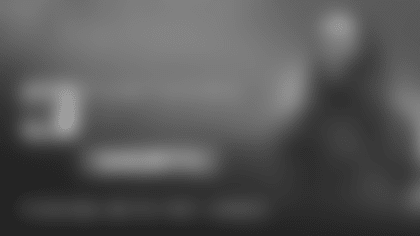The Patriots. The Rams.
The combatants in Super Bowl LIII, yes. But also the franchises that longtime Panthers fans automatically associate with their Super Bowl experience.
For Patriots and Rams fans, this year's matchup no doubt conjures up memories of the teams' monumental Super Bowl clash at the conclusion of the 2001 season. The then-St. Louis squad's "Greatest Show on Turf" ruled the realm, while the Patriots were the plucky, upstart underdogs led by a sixth-round draft pick who had replaced injured star Drew Bledsoe.
Now Tom Brady is trying to tuck his five Super Bowl rings out of view and paint the Patriots as underdogs anew, but no one is buying it. Certainly not in the way his first Super Bowl team was viewed 17 years ago, and certainly not the way the Panthers were viewed two years after that.
That year, 2003, was when the Patriots and Rams forever became a part of shared history for Panthers fans.

The Patriots and Rams didn't actually enter the 2003 season as overwhelming favorites. After New England stunned the Rams in the Super Bowl following the 2001 season, the 2002 Patriots missed the playoffs. Many believed Brady might be a one-hit wonder at that point, but he began writing a different narrative in 2003 and New England cruised to a 14-2 mark in the regular season.
The 2003 Rams, meanwhile, were working to retool their offensive juggernaut of a roster at the most critical position. Injuries had derailed quarterback Kurt Warner and St. Louis also had missed the 2002 playoffs, but in 2003 Marc Bulger did his best Warner impression and led the likes of Marshall Faulk, Torry Holt and Isaac Bruce to a 12-4 record.
So those teams entered the postseason among the favorites, along with the Eagles in the NFC and the Chiefs in the AFC.
The Panthers? They weren't on many people's radar. Sure they were a feel-good story in the regular season, starting out with zero expectations with Rodney Peete under center and ending the season as NFC South champs with Jake Delhomme and Co. showing a penchant for the dramatic. Still NFL fans at large didn't think that much of the 11-5 squad when even when Carolina easily dispatched the Cowboys under first-year coach Bill Parcells (Sean Payton was his first-year offensive coordinator) in the wild card round.
That changed in the next round. Against the Rams.

Things hadn't been seamless for St. Louis since the Super Bowl loss to the Patriots two years earlier, but they had remained close to unbeatable at home. The Rams won their final five home games in 2002 despite their overall mark of 7-9, and in 2003 they won all eight games at home.
The last time Carolina had visited the Edward Jones Dome (the Trans World Dome at the time) was in 2001, when the teams were foes in the old NFC West for the final time. The Rams rolled 48-14.
But it was a different story on a historic day for the Panthers' fledgling franchise – and a notable day in NFL annals. The Panthers' defense kept the Rams offense reasonably under wraps, with Delhomme and Co. building a 23-12 edge midway through the fourth quarter before St. Louis steamed back with a Faulk touchdown, a two-point conversion, an onside kick recovery and a field goal on the final play of regulation to force overtime.
This classic required two overtimes – the first double-overtime playoff game in 17 years – before the Panthers pulled it out on arguably the most famous play in franchise history: Steve Smith's 69-yard touchdown on the first play of the second OT.
The next week, Carolina's dominant defensive effort at the Eagles resulted in a 14-3 victory and the first Super Bowl berth for the franchise – opposing the Patriots. After being two-touchdown underdogs in their Super Bowl victory over the Rams two years early, the Patriots were installed as touchdown-favorite over the Panthers.
In Super Bowl XXXVIII, defense again seemed to rule the day – until it didn't. The Patriots led 14-10 entering one of the most compelling quarters in Super Bowl history, a fourth quarter that featured 37 points, an 11-point rally by the Panthers and two lead changes. Alas, we all know how it ended: on Adam Vinatieri's 41-yard field goal with four seconds left that gave New England a 32-29 triumph.

But did you know how closely that finish mirrored the Patriots-Rams finish two years earlier? In both games, Ricky Proehl caught a touchdown pass in the waning seconds to tie the score (with 1:08 left for the Panthers; with 1:21 left for the Rams). And in both games, Brady responded by quickly moving the Patriots into range for Vinatieri to claim the victory (from 41 yards versus the Panthers; from 47 versus the Rams). Brady's final completion against the Rams was to Jermaine Wiggins, who started at tight end for the Patriots in Super Bowl XXXVI and for the Panthers in Super Bowl XXXVIII, catching two passes in both games.
A lot has changed since that magical run for the Panthers, and since the last Super Bowl featuring the Rams and Patriots. New England has won three Super Bowls and lost three since knocking off the Panthers. The Rams haven't been to the Super Bowl since falling to the Patriots, and they've moved from St. Louis back to Los Angeles.
If this one is as good as those – when the Patriots and Rams defined the era and were key components in Carolina defining its early history as a franchise, then it'll be worth tuning in.






